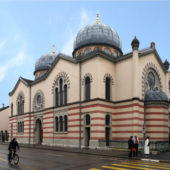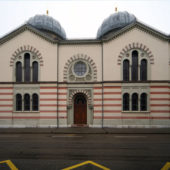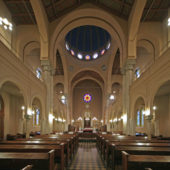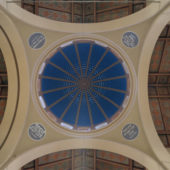The First Zionist Congress was held in Basel in 1897. Originally it was to be held in Germany but was moved to Basel because of rabbinical protests in Germany. Theodor Herzl wrote in his diary, “To summarize the Basel Congress in one sentence – which I shall be careful not to pronounce publicly – it is this: I have founded the Jewish state in Basel.”
Switzerland has had a settled Jewish community since the 13th century. In 1213, Basel was one of the largest Jewish communities in Europe. The community flourished until 1348, at which time the Black Plague occurred and the Jews, accused of poisoning the wells, were subsequently tortured and persecuted. 600 Jews were burned at the stake and by 1349, the Jewish community in Basel dissolved. In 1349, most Jews were expelled from Switzerland, many of whom returned to Zurich by 1352 and to Basel by 1361. However, the Jews continued to be persecuted and were again accused of blood libel and burned at the stake. Jews were banished again from Basel in 1543, although they again soon found their way back. Select Jews were soon admitted back into Basel when Christian printers began printing Hebrew texts. They required Jews to proofread the texts, thus hundreds of residency permits for Jews were provided.
Beginning in the early 14th century, many Swiss towns began giving Jews permanent residency. However, in the 1620s and from 1776, the Jews were again expelled from most Swiss towns, except from what is now Aargau, Lengnau, and Oberendingen. Like most of Europe, Jews were largely confined to banking and money lending. Because the economy would not function properly in Switzerland without Jews, since they performed banking and money lending, they were never expelled from the country for long. Jews were required to wear a Judenjut (Jew hat), except for some physicians. They were required to live in certain neighborhoods. The neighborhood infrastructure, included their mikvot (ritual baths), slaughterhouses, synagogues and cemeteries.
The Swiss Jews’ fight for emancipation was long and hard. Prior to that, they were considered aliens. Special permission to marry was required and their business activities were heavily regulated. In 1805 Basel allowed Jews back into the city. They did not receive the same financial assistance for schools that other Swiss citizens received. By 1864 the community of Jews in Basel reached 300 members. Switzerland was one of the last countries in the Europe to grant Jews emancipation, which occurred in 1874. Only Spain and Portugal took longer. In 1874, after the Jews received full civil rights, the community grew significantly. However, they were still not allowed to perform ritual slaughter, because it was considered to be cruel to animals.
The First Zionist Congress was held in Basel in 1897. In 1903, a Jewish cemetery was founded in Basel. Prior to and during WWII, Switzerland provided refuge for approximately 23,000 Jews, who were protected throughout the Holocaust because Switzerland was a neutral country. However, even more, nearly 30,000, were denied refuge in Switzerland during that period. In 1996, Swiss President Kastar Villiger formally made an apology to world Jewry for the country’s accord with Nazi activities against the Jews. In 1956, after the Sinai Campaign and Hungarian Uprising, the Swiss Federation of Jewish Communities provided relief for Jewish refugees from Egypt and Hungary. In 1968, Switzerland provided refuge for Jews who fled from Czechoslovakia to Switzerland. Today’s Jewish population is organized and united. There are over 23 Jewish organizations and 17 Jewish communities. In 2000, there were approximately 17,914 Jews in Switzerland, with Basel having approximately 2,000, the second largest Jewish community in the country. The country has seen an upsurge in anti-Semitism, which has been relatively mild over recent years.
The Great Synagogue complex in Basel comprises the Synagogue itself, a kosher restaurant, a community center, a mikvah (ritual bath) and a school. The congregation runs youth clubs, sports clubs and several social groups. The Great Synagogue’s choir consists of sixteen males. They perform from a large repertoire of Jewish liturgical songs both for services and concerts.
The Great Synagogue was originally built in 1868 as a single-domed structure. The Synagogue has been expanded and renovated several times over the past 150 years, and significantly so in 1947. The neo-Romanesque façade now features a twin-domed structure, featuring tri-lancet windows flanking the entranceway, with a round window just above the entrance. The façade is cream, and the lower half has brickwork placed horizontally to create red and cream horizontal striping popularized in Italian Renaissance architecture.
Inside the spacious prayer room, there are sweeping ivory arches and columns and a pitched wood coffered ceiling. Arched, stained-glass windows run along the side walls, on the ground and upper stories. Black and ivory diamond-shaped tiles lead the way up the aisle to the bimah, which is elevated up several marble steps. The wall against which the Aron Kodesh is situated is intricately painted with a neo-Romanesque motif in subtle tan, blue and red. The Aron Kodesh is placed under an arch of gold and royal blue flecked with golden stars. White columns flank either side of the black pelmet and Torah curtain, which is embroidered in gold. A round stained glass window is situated above the Aron Kodesh. The wood tivah (reader’s desk) is placed on the bimah in front of the Aron Kodesh. A second tivah is situated in the center of the sanctuary surrounded by a wood balustrade. Several intricately wrought brass menorahs are situated on the platform. A marble balustrade runs across the front of the platform. Cupolas are situated at the front and back of the prayer room, punctuated with round stained-glass windows. The women’s gallery is upstairs, running along the side and back walls.






